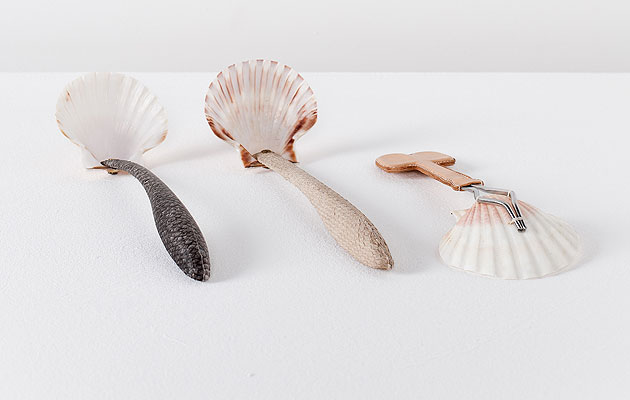|
|
||
|
“People are very sensitive when it come to leather,” explains Simone Farresin of design duo Studio FormaFantasma: “They know where it comes from but they don’t want that to be apparent.” Farresin and his partner Andrea Trimachi both studied in Florence where “it is hard to avoid the leather industry”, and in their Craftica collection, which he describes as their “homage to leather”, they wanted to question the stereotype that the material “just comes from a cow or pig”. In their material investigation into leather, they intended to make the origins of the unusual skins they used very clear. Fendi, the Florence-based fashion house that sponsored the project, which was on display at Design Miami/Basel, was apparently a little concerned by FormaFantasma’s wilful primitivism. The studio worked not only with the discarded off-cuts from Fendi’s range of products but also with a multiplicity of other leathers – including vegetal dried salmon and perch skins, and the fierce-looking Atlantic wolfish. These were “discarded skins from the food industry” rather than prized exotic leathers, the majority sourced from a factory in Iceland. They give a tactile, pre-industrial glamour to a range of bespoke products: a stool, with a generous coral sponge as its seat, is held up by legs covered in tanned salmon skins; an elegant spoon, whose bowl is a scallop shell, has a handle covered in trout; side tables are covered in perch or wolfish. The duo wanted to present “a holistic view of leather” and also used boar bristles, goatskins and cow bladders, the latter bought from local farmers to create tabletop vessels. As if to acknowledge the curing and tanning process that Farresin admits was “stinky”, they constructed two protective masks out of discarded Fendi leather and scallop shells, through which air holes have been drilled.
Other items include a room divider that resembles a blacksmith’s apron, its pocket weighted with a marble millstone, and a long leather table over which a skin is stretched by columns of marble weights (they will be on sale through Gallery Libby Sellers). “It was a challenge,” Farresin admits, “to combine so many different kinds of material – leather, marble, glass, brass – into a visually cohesive assembly.” They also wanted their exhibition to tell a story of the use of leather through the ages, and the pieces were accompanied by a series of comic illustrations on parchment by Francesco Zorzi, who now works in their studio, that show a picaresque history, from the leather used in medieval armour through to contemporary fetishism. |
Image Formafantasma
Words Christopher Turner |
|
|
||


















